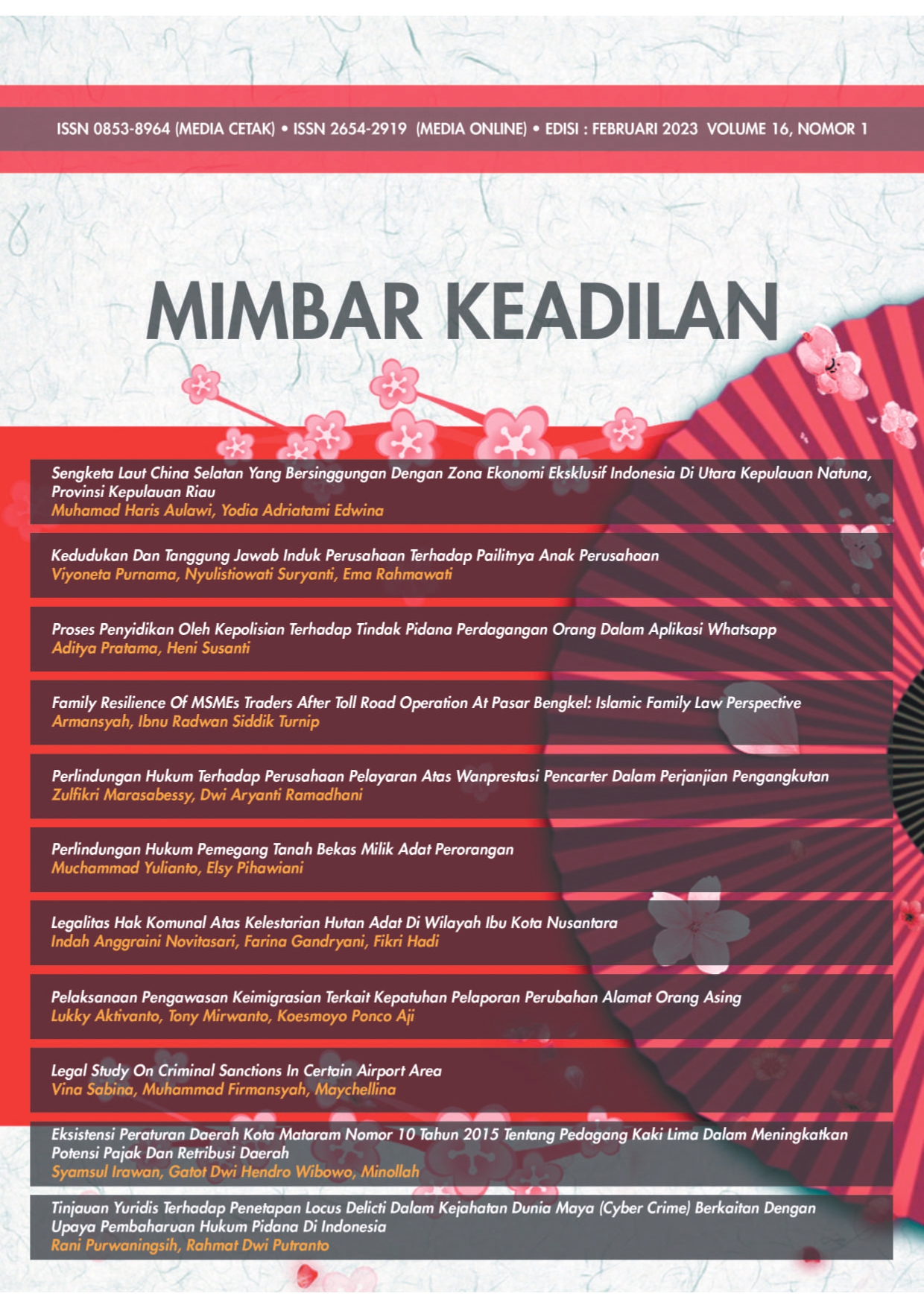Sengketa Laut China Selatan yang Bersinggungan Dengan Zona Ekonomi Ekslusif Indonesia di Utara Kepulauan Natuna, Provinsi Kepulauan Riau
Abstract
The purpose of this research is to describe China's unilateral claims in the South China Sea through the nine-dash line map that intersects with Indonesia's EEZ in accordance with UNCLOS 1982 where Indonesia finally took a stand on China's unilateral claims in the South China Sea in the northern sea of Natuna. It is hoped that this research can be useful as a basis for the development of science, especially in the field of international maritime law. This research uses a normative legal research method with statue approach and a case approach where various literature is related as secondary data that will strengthen the research arguments. Indonesia's relationship with China is heating up because China's unilateral claim in the waters of the South China Sea through a nine-dash line map is intersecting with the territory of Indonesia's maritime zone, the Exclusive Economic Zone of Indonesia in the Northern Natuna Islands of Riau Islands Province which has been recognized according to the United Nations Convention on the Law of the Sea (UNCLOS) 1982. The results showed that the nine-dash line claims by China did not comply with UNCLOS 1982, a misunderstanding between Indonesia and China led the two countries to mediate and requested that China respect the provisions of international law, especially UNCLOS 1982 as the world maritime constitution.
Downloads
References
Adi, Danang Wahyu Setyo. 2020. ‘Analisis Penyelesaian Sengketa Laut China Selatan Oleh Badan Arbitrase Internasional’, Jurnal Hukum Lex Generalis, 1.3: 39–51
Ardila, Ririn, and Akbar Kurnia Putra. 2021. ‘Sengketa Wilayah Zona Ekonomi Eksklusif Indonesia (Studi Kasus Klaim Cina Atas Laut Natuna Utara)’, Uti Possidetis: Journal of International Law, 1.3: 358–77 <https://doi.org/10.22437/up.v1i3.10895>
Azanella, Luthfia Ayu. 2020. ‘Dianggap Langgar Teritori Di Natuna, Kemenlu China Sebut Negaranya Punya Hak’, Kompas.Com
Callista, Prameshwari Ratna, Muchsin Idris, and Nanik Trihastuti. 2017. ‘Klaim Tiongkok Tentang Traditional Fishing Ground Di Perairan Natuna Indonesia Dalam Perspektif UNCLOS 1982’, Diponegoro Law Journal, 6.2 (Program Studi S1 Ilmu Hukum, Fakultas Hukum, Universitas Diponegoro): 1–13
Chapman, Bert. 2016. ‘CHINA’S NINE-DASHED MAP’, Geopolitics, History, and International Relations, 8.1 (JSTOR): 146–68
Cogliati-Bantz, Vincent P. 2016. ‘The South China Sea Arbitration (The Republic of the Philippines v. The People’s Republic of China)’, The International Journal of Marine and Coastal Law, 31.4 (Brill Nijhoff): 759–74
Djalal, Hasjim. 1979. Perjuangan Indonesia Di Bidang Hukum Laut (Badan Pembinaan Hukum Nasional, Departemen Kehakiman)
Halim, Devina. 2020. ‘No TitleJadi Dasar China Klaim Natuna, Nine-Dash Line Dinilai Tak Berdasar’, Kompas.Com <https://nasional.kompas.com/read/2020/01/05/19321561/jadi-dasar-china-klaim-natuna-nine-dash-line-dinilai-tak-berdasar?page=all> [accessed 16 March 2021]
Indonesia.go.id. 2020. ‘Sengketa Di Kawasan Laut Natuna Utara’, Indonesia.Go.Id <https://indonesia.go.id/narasi/indonesia-dalam-angka/politik/sengketa-di-kawasan-laut-natuna-utara> [accessed 16 March 2021]
Khaliq, Riyaz Ul. 2021. ‘3 Reasons China Tries to Control South China Sea’ <https://www.aa.com.tr/en/asia-pacific/3-reasons-china-tries-to-control-south-china-sea/2157110> [accessed 16 March 2021]
Kompas.com. 2016. ‘Konflik RI-China Di Natuna’, Kompas.Com <https://www.kompas.com/topik-pilihan/list/4065/konflik-ri-china-di-natuna> [accessed 16 March 2021]
Korkut, Ekrem, and Woo Hyun Kang. 2017. ‘China’s Nine Dash Line Claim in Light of the Ruling by the Permanent Court of Arbitration (12 July 2016)’, Penn St. JL & Int’l Aff., 5 (HeinOnline): 425
Mukti Fajar, N D, and Yulianto Achmad. 2019. ‘Dualisme Penelitian Hukum Normatif Dan Empiris, Cetakan Kelima’ (Yogyakarta: Pustaka Pelajar)
Pradana, Raden Florentinus Bagus Adhi. 2017. ‘Akibat Hukum Klaim Nine Dash Line Cina Terhadap Hak Berdaulat Indonesia Di Perairan Kepulauan Natuna (Khususnya Kabupaten Natuna) Menurut Unclos 1982’, . (UAJY): 1–10
Prayuda, Rendi, and Fanesa Angeli. 2020. ‘ANALISIS IMPLEMENTASI KONSEP COC (CODE OF CONDUCT) DALAM PENYELESAIAN KONFLIK DI LAUT NATUNA UTARA’, Jurnal PIR : Power in International Relations, 4.2: 137 <https://doi.org/10.22303/pir.4.2.2020.137-150>
Rapang, I., Z. Fanani, S. Widagdo, and T. Domani. 2020. ‘MARITIME POLICY INTEGRATION MODEL AT NATUNA ON THE DEFENSE AND SECURITY PERSPECTIVE’, Russian Journal of Agricultural and Socio-Economic Sciences, 100.4: 73–85 <https://doi.org/10.18551/rjoas.2020-04.11>
SUMARLAN, SUTRIMO, SUDIBJO, and AHMAD G. DOHAMID. 2021. ‘Indonesia Defence Diplomacy Strategy in Resolving China Claims to Indonesia Exclusive Economic Zone in North Natuna Sea’, Journal of Contemporary Issues in Business and Government, 27.02 <https://doi.org/10.47750/cibg.2021.27.02.033>
Syahrianto, Muhammad. 2020. ‘Apa Itu Nine Dash Line Atau 9 Garis Putus-Putus, Yang China Klaim Di Laut Natuna?’, Wartaekonomi.Co.Id <https://www.wartaekonomi.co.id/read265313/apa-itu-nine-dash-line-atau-9-garis-putus-putus-yang-china-klaim-di-laut-natuna> [accessed 16 March 2021]
Tampi, Butje. 2018. ‘Konflik Kepulauan Natuna Antara Indonesia Dengan China (Suatu Kajian Yuridis)’, Jurnal Hukum Unsrat, 23.10
United Nations. 1982. ‘United Nations Conventions on the Law of the Sea 1982’
Authors who publish with Mimbar Keadilan agree to the following terms:
- Authors transfer the copyright and grant the journal right of first publication with the work simultaneously licensed under a Creative Commons Attribution-ShareAlike 4.0 International License.. that allows others to share the work with an acknowledgement of the work's authorship and initial publication in this journal.
- Authors are able to enter into separate, additional contractual arrangements for the non-exclusive distribution of the journal's published version of the work (e.g., post it to an institutional repository or publish it in a book), with an acknowledgement of its initial publication in this journal.
- Authors are permitted and encouraged to post their work online (e.g., in institutional repositories or on their website) prior to and during the submission process, as it can lead to productive exchanges, as well as earlier and greater citation of published work (See The Effect of Open Access)






